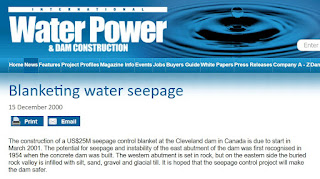The construction of a US$25M seepage control blanket at the Cleveland dam in Canada is due to start in March 2001. The potential for seepage and instability of the east abutment of the dam was first recognized in 1954 when the concrete dam was built. The western abutment is set in rock, but on the eastern side the buried rock valley is infilled with silt, sand, gravel and glacial till. It is hoped that the seepage control project will make the dam safer.
https://www.waterpowermagazine.com/features/featurethe-case-of-cleveland-dam/
"Cleveland dam is a 91m high concrete gravity structure set in a deep bedrock canyon. Full reservoir supply level is at el. 146m and the dam crest is at el. 149m. In 1992, the dam was upgraded to pass the Probable Maximum Flood (PMF) and to withstand the Maximum Design Earthquake (MCE) event.
The dam impounds a reservoir extending 4.5km to the north where the Upper Capilano river flows into the reservoir. Typically 0.5km wide, the reservoir surface area is 2.3km2 at full reservoir level. Flow is controlled at the dam by a radial gate spillway, two mid-level intakes and outlets, and two low-level outlets."
"The dam is constructed in a bedrock canyon on the west side of the valley. Immediately east of the canyon is a wide, deep buried valley that extends about 2km (eastward from the dam to the base of Grouse Mountain. The buried valley extends to below sea level and is infilled with a complex stratification of silt, sand, gravel and glacial till. The west canyon bedrock is hard, moderately jointed granodiorite and quartz diorite with numerous inclusions of older sedimentary and volcanic rocks."
**********************************
Additional Reading
Metro Vancouver utilising hydro potential at non-powered dams
05 December, 2012
Metro Vancouver in Canada is proposing to generate
electricity from its dams during rain drenched months of the year. The
supply of high quality drinking water will remain the first priority of a
new water use plan for the Capilano and Seymour Watersheds, which
includes the Cleveland dam. Built in 1954 to create Capilano Lake for
water storage, the dam currently does not capture energy from spilled
water.
Seismic upgrade of Seymour Falls dam
23 May, 2006
The Seymour Falls dam is a key element in Canada’s
Greater Vancouver Water District’s (GVWD) network of three watersheds.
The 45-year-old composite earth fill embankment and concrete slab and
buttress dam was found to not meet current seismic design standards, so
upgrades to meet the requirements of the Maximum Credible Earthquake
(MCE) are necessary. Part one of our two part report describes the
structure and looks at how the safety problem was identified and
analyzed through site investigation and liquefaction assessment
08 December, 2005
The Case of Cleveland Dams Neil Singh, Ryan Douglas, Steve Ahlfield and Murray Gant describe the work involved in the construction of an RCC upstream blanket and plastic concrete cutoff wall at Cleveland dam in Canada
Search Results For: Cleveland Dam
